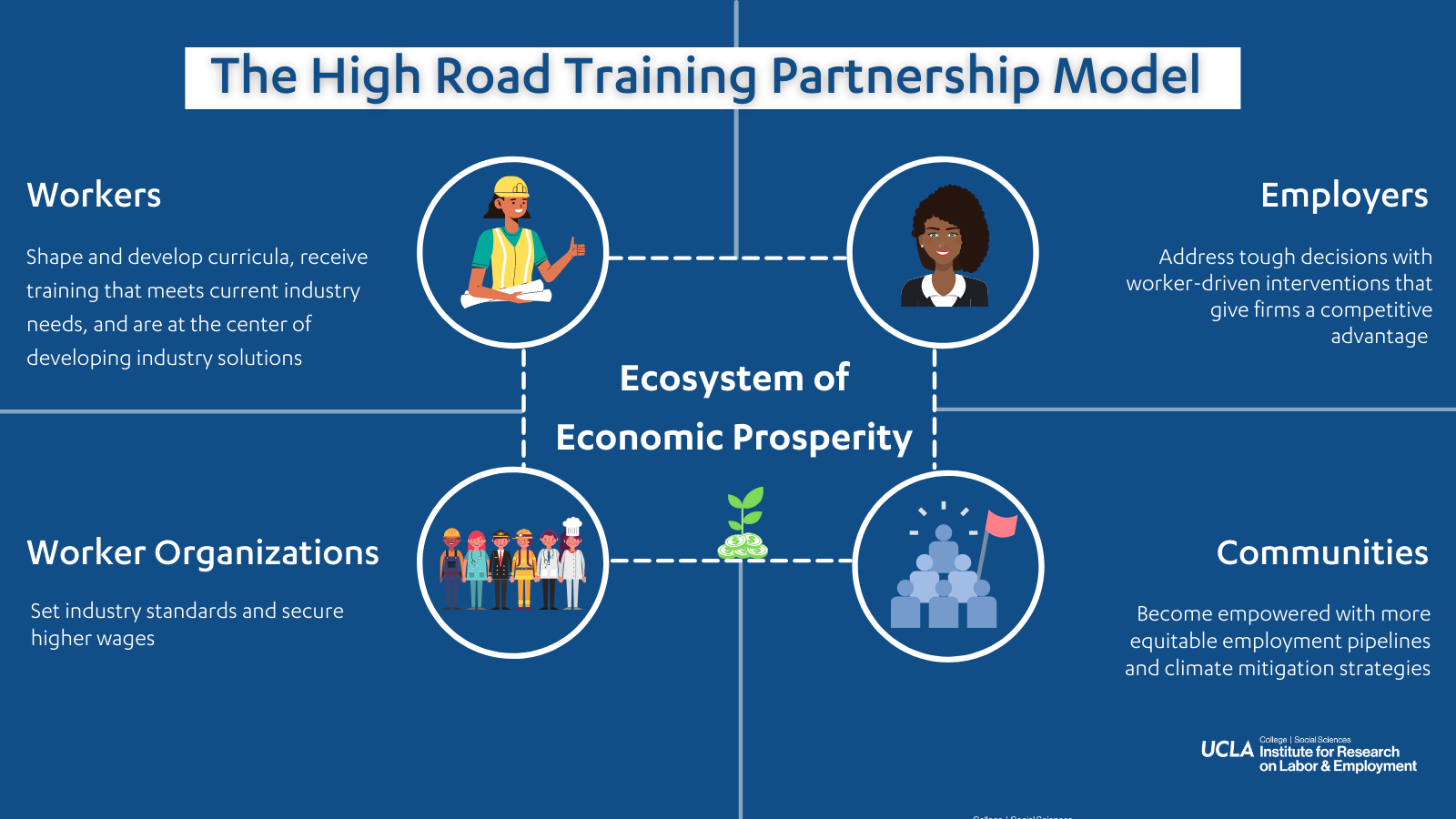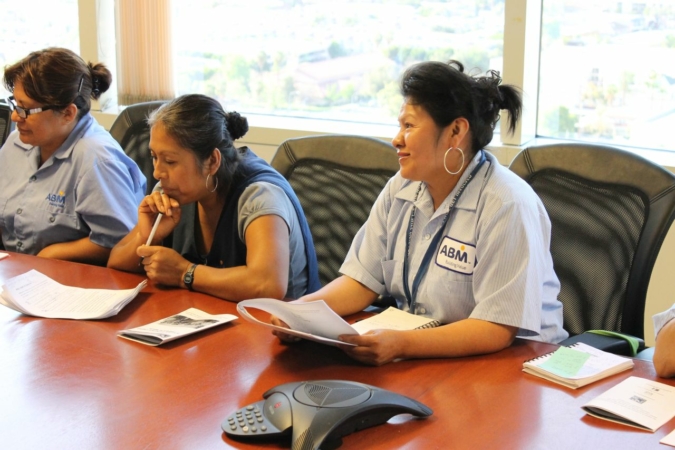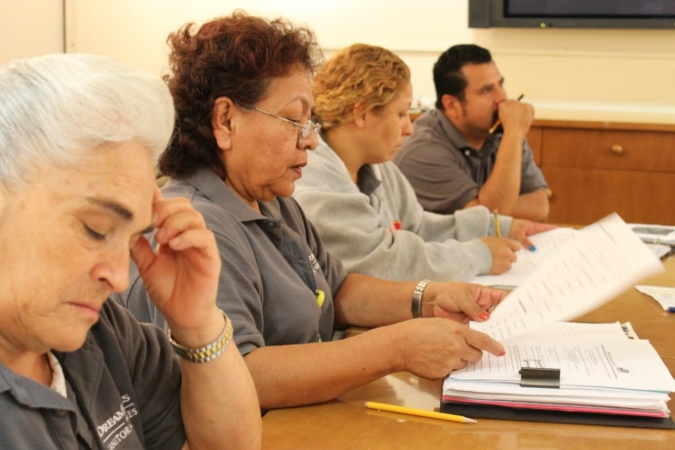UCLA Labor Center to expand research and support of high road approaches to work this fall
In partnership with the California Workforce Development Board (CWDB), Labor Center researchers are leading the way in how we envision workforce development across the state
Citlalli Chávez-Nava | November 15, 2021
Last summer, UCLA Labor Center researchers released an evaluation of a variety of demonstration projects that formed part of an 18-month High Road Training Partnership (HRTP) initiative launched by the California Workforce Development Board (CWDB). The projects aimed to increase labor-management “high road” approaches to work with the goal of delivering equity, climate resilience and quality jobs across the state.
In their assessment, researchers drew important lessons on how this innovative approach to workforce development is responsive to change, prioritizes systemic issues like racial inequality, offers a more inclusive definition of industry leadership, builds collective power and provides a framework that advances a shift in how workforce development is evaluated.
These lessons will inform the next phase of this work later this fall.
In 1990, Joel Rogers, sociologist at the University of Wisconsin-Madison, proposed the “high road” as “a family of strategies for human development under competitive market conditions that treat shared prosperity, environmental sustainability, and efficient democracy as necessary complements, not tragic tradeoffs.”
On the contrary, the “low road” approach to work is exploitative and only considers short-term goals for a company, said Magaly Lopez, senior research analyst at the UCLA Labor Center.
The HRTP demonstration projects aim to bring high road labor models to parts of the state that have been economically disenfranchised for decades.
“High Road Training Partnerships provide an infrastructure of support in which workers, unions and employers work collaboratively to develop solutions that meet both employers’ needs and workers’ needs in real time. HRTPs start with in-demand jobs and focus on reskilling and upskilling the workforce. Workers shape programs and curricula, train and mentor others and are at the center of developing industry solutions,” said Ana Luz Gonzalez-Vasquez, project manager at the UCLA Labor Center.
Media Contact
Citlalli Chávez-Nava
citlallichavez@ucla.edu
“We wanted to make sure that the evaluation wasn’t using the typical measures of success for workforce development, which are heavily focused on counting the number of job placements” said Lopez.
As Labor Center researchers began their evaluation, they were intentional about approaching the assessment leveraging the center’s longstanding worker justice lens.
“We wanted to make sure that the evaluation wasn’t using the typical measures of success for workforce development, which are heavily focused on counting the number of job placements” said Lopez.
Instead, researchers adopted a qualitative approach that included a “theory of change framework” which facilitated a deeper analysis of each HRTP and a more holistic assessment of the long-term economic outcomes for workers.
“Equity was really important in our assessment because it’s not just about making sure that people have a job. It’s about who has access to quality jobs and whether the job provides appropriate support for workers to thrive and an opportunity for economic mobility,” said Gonzalez-Vasquez.
A High Road Training Partnership in Practice
Within the High Road Training Partnership (HRTP) model, intermediary organizations that convene workers, unions and employers serve as the glue that make collaboration possible.
Born out of the Justice for Janitors movement, Building Skills Partnership (BSP), is an example of such an organization. Since 2007, BSP has offered unionized janitors, members of SEIU-United Service Workers West, skills that support their development at work and improve their overall quality of life. As is evident in the organization’s 2020 report, BPS’s work is impactful by offering programs that address urgent immigrant worker needs such as English language attainment, citizenship and digital and financial literacy.
BSP’s approach is also versatile and responsive, a method that was put to the test in the initial months of the COVID-19 pandemic when cleaning companies grappled with keeping the public and janitorial staff members safe.
“The union and the employers came together and we worked with content experts to develop a program which evolved to become an infectious disease certification,” said BSP Executive Director Luis Sandoval.
The 12-hour program trained workers in “cleaning and disinfecting against deadly pathogens” and proper use of personal protective equipment (PPE), among other topics. Since the start of the pandemic, the program has successfully trained over 1000 workers.
Alma Bolaños, a Pasadena-area janitor who completed the infectious disease certification last spring, gets emotional as she remembers the uncertainty and fear of infection when very little was known about the transmission of the virus. Yet, she felt supported by BSP’s interventions at a time when she almost considered leaving her job to avoid infection.
“For us, the training was very important because [BSP] gave us the tools, the reassurance to continue working,” said Bolaños. “And then I even brought that knowledge back home to my family–I provided them with some peace of mind.”
Bolaños has also participated in a variety of BSP courses that have improved other aspects of her life. Over the years, she has enrolled in English, financial literacy and health and wellness classes.
“I opened up a bank account at a credit union, learned how to manage my money, and how to save,” added Bolaños enthusiastically. “I’ve also lost weight and even became a health ambassador…even my son has noticed that I cook differently, I now make more salads and we eat out less frequently.”
Bolaños’ experience reflects BSP’s mission and the HRTP overall goal of improving workers’ quality of life.
“Our partnership with SEIU-USWW represents the future of the labor movement that addresses broader worker needs,” said Sandoval. “We do one job training but that impacts what’s happening at the workplace and that impacts what’s happening at home and what’s happening at home impacts what’s happening in the community. It’s a ripple effect that gets multiplied.”
“For us, the training was very important because [BSP] gave us the tools, the reassurance to continue working,” said Bolaños. “And then I even brought that knowledge back home to my family–I provided them with some peace of mind.”
Partnering with Employers
Proponents of high-road approaches to workforce development often tout the “win-win” nature of building a mutually beneficial relationship between employers and workers. These partnerships allow the parties to re-envision the way they relate to one another despite some likely initial hurdles.
“We don’t want to romanticize the partnerships,” said Gonzalez-Vasquez. “It’s not something that feels right initially, but once workers, employers and worker representatives start to work together, that’s when you see the magic happen. By working in partnership, they develop relationships that are built on trust and a mutual respect for each others’ expertise.”
In turn, Labor Center researchers found that building collaborative relationships give firms a competitive advantage and more worker ownership over their role in the company.
“Professionalism is a big thing for us. So if we can say that our people are educated, skilled and a professional team, that goes a long way to improve the relationship between the janitorial industry and the owners of the buildings,” said Jose Gonzalez, manager of operations at UG2 during a recent interview.
At the same time, while the recent assessment sets a good foundation to move toward a comprehensive evaluation of growing HRTP initiatives throughout the state, the Labor Center recognizes it’s early to measure tangible impacts.
“We’re currently in an educational phase. So part of what we asked the organizations was to define success for themselves which is truly innovative. We highlighted some initial observations in the successes section of our report, but we’re not necessarily saying this success is a measure or a metric,” said Lopez. “You can’t measure impact in such a short period of time, you have to give it time, you have to complete a few cycles before you get to an impact assessment.”
The Next Iteration of Work
As the state and nation continue to face the inequities unveiled by COVID-19 pandemic and the detrimental impacts of climate change, researchers will work with the California Workforce Development Board to bring the HRTP model to workforces that have never had such opportunities and to develop an evaluation framework that best captures the successes of organizations that serve them.
“Initially, HRTPs only included unions as partnership conveners, but now worker centers are forming HRTPs, and hopefully HRTPs will expand not only to worker centers, but other community-based organizations that are serving some of the most marginalized communities like undocumented, justice-impacted, and housing insecure individuals,” said Gonzalez-Vasquez.
For this effort, Labor Center researchers plan to launch a statewide network of labor centers that will build upon previous research and evaluation to create a process for long-term technical assistance to HRTPs.
This fall, the Labor Center will convene with faculty and staff across the University of California including the UC Berkeley Labor Center, UC Merced Community and Labor Center and UC Riverside to develop a strategic plan that supports rapidly-expanding HRTP models across the state.
“Our hope is to transform the way we assess and discuss the impact of these partnerships on workers of color and their communities and to ensure all workers have a fair shot at jobs that lift up their quality of life,” added Lopez.
Learn more about the High Road Training Partnership Initiative:
The High Road to Economic Prosperity Full Evaluation/Report
UCLA Labor Center researchers curated a repository of workforce development resources to support organizations advancing equity in California’s public workforce development system. The repository can be accessed here: https://www.labor.ucla.edu/new-worker-equity-initiative-repository/





